Items filtered by date: January 2024
Athlete’s Foot Symptoms and Risk Factors
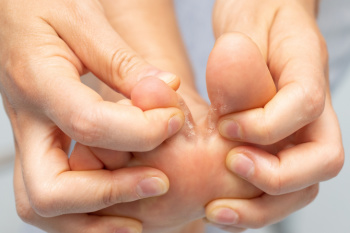
Athlete's foot, a prevalent fungal infection, predominantly affects the feet, with the skin between the toes being especially vulnerable. Athlete's foot is caused by various fungi, with the most common being trichophyton, which thrives in warm, humid environments. Athlete’s foot infections result in a moist, itchy, red, or flaky rash between the toes. Other symptoms are cracked, scaly, or peeling skin and stinging and burning sensations on cracked skin. Itchy blisters that form may burst and leave scales, and result in a dry, scaly rash on the soles and up the sides of the foot. If left untreated, athlete's foot can progress to more severe stages, with symptoms such as bleeding from cracked skin and white, soggy skin in toe webbing. An unpleasant odor, oozing blisters, and pain in affected areas can occur. Thickened, crumbly, or discolored toenails may develop if the fungus spreads. Transmission occurs through contaminated floors in shared spaces like showers and changing rooms, as well as in socks, clothing, and used towels. Prevention involves practicing good foot hygiene, wearing well-ventilated shoes, and avoiding walking barefoot in communal areas. For a severe case of athlete’s foot, it is suggested that you schedule an appointment with a podiatrist for advanced treatment.
Athlete’s foot is an inconvenient condition that can be easily reduced with the proper treatment. If you have any concerns about your feet and ankles, contact Patrice Antero, DPM from Tuscany Podiatry. Our doctor will treat your foot and ankle needs.
Athlete’s Foot: The Sole Story
Athlete's foot, also known as tinea pedis, can be an extremely contagious foot infection. It is commonly contracted in public changing areas and bathrooms, dormitory style living quarters, around locker rooms and public swimming pools, or anywhere your feet often come into contact with other people.
Solutions to Combat Athlete’s Foot
- Hydrate your feet by using lotion
- Exfoliate
- Buff off nails
- Use of anti-fungal products
- Examine your feet and visit your doctor if any suspicious blisters or cuts develop
Athlete’s foot can cause many irritating symptoms such as dry and flaking skin, itching, and redness. Some more severe symptoms can include bleeding and cracked skin, intense itching and burning, and even pain when walking. In the worst cases, Athlete’s foot can cause blistering as well. Speak to your podiatrist for a better understanding of the different causes of Athlete’s foot, as well as help in determining which treatment options are best for you.
If you have any questions please feel free to contact our office located in Tuscaloosa, AL . We offer the newest diagnostic and treatment technologies for all your foot and ankle needs.
Treatment Options for Hammertoe
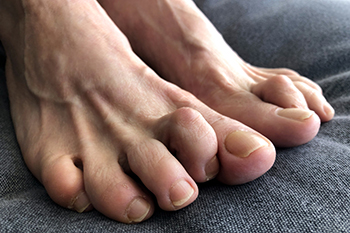
Hammertoe, a condition where one or more toes bend abnormally at the middle joint, resembling a hammer, can result from various causes. One major factor is ill-fitting footwear, especially shoes with a tight toe box or high heels, forcing toes into a bent position and causing muscle imbalances. Individuals with longer toes, flat feet, or bunions are more susceptible, as are those with a family history of the condition. Hammertoe symptoms include toe deformity, pain, calluses, swelling, and difficulty in walking. Diagnosis involves a physical exam and X-rays, and treatment options depend on toe flexibility. In early stages, nonsurgical approaches like proper footwear, exercises, and splints can help. Surgery may be necessary if the toe becomes rigid. Early intervention is essential to manage hammertoe effectively. If you have a hammertoe that is causing you discomfort, it is suggested that you schedule an appointment with a podiatrist for the best treatment option for you.
Hammertoes can be a painful condition to live with. For more information, contact Patrice Antero, DPM of Tuscany Podiatry. Our doctor will answer any of your foot- and ankle-related questions.
Hammertoe
Hammertoe is a foot deformity that occurs due to an imbalance in the muscles, tendons, or ligaments that normally hold the toe straight. It can be caused by the type of shoes you wear, your foot structure, trauma, and certain disease processes.
Symptoms
- Painful and/or difficult toe movement
- Swelling
- Joint stiffness
- Calluses/Corns
- Physical deformity
Risk Factors
- Age – The risk of hammertoe increases with age
- Sex – Women are more likely to have hammertoe compared to men
- Toe Length – You are more likely to develop hammertoe if your second toe is longer than your big toe
- Certain Diseases – Arthritis and diabetes may make you more likely to develop hammertoe
Treatment
If you have hammertoe, you should change into a more comfortable shoe that provides enough room for your toes. Exercises such as picking up marbles may strengthen and stretch your toe muscles. Nevertheless, it is important to seek assistance from a podiatrist in order to determine the severity of your hammertoe and see which treatment option will work best for you.
If you have any questions, please feel free to contact our office located in Tuscaloosa, AL . We offer the newest diagnostic and treatment technologies for all your foot care needs.
Strategies That May Help Prevent Running Injuries
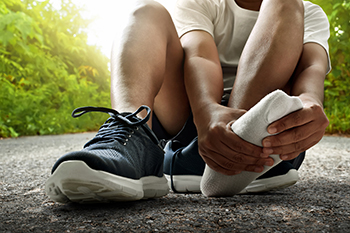
Research reveals that nearly half of recreational runners sustain injuries, often affecting the Achilles tendon, calf, knee, ankle, lower leg, feet, and toes. Various factors contribute to injury risk, including running mechanics, footwear, and abrupt mileage increases. Fortunately, effective strategies exist to prevent running injuries before they disrupt your routine. It is essential to understand that injury prevention is complex, with factors like anatomy, history of injuries, and training methods playing roles. Each runner is unique, possessing distinct anatomical traits and injury histories, making injury prevention a challenging task. To reduce injury risk, experts recommend focusing on building a strong body, maintaining proper form, and choosing suitable footwear. Achieving a balance among these factors can significantly lower the likelihood of injuries, ensuring a rewarding and injury-free running experience. It is also advisable to schedule an appointment with a podiatrist for personalized advice on preventing running injuries.
All runners should take extra precaution when trying to avoid injury. If you have any concerns about your feet, contact Patrice Antero, DPM of Tuscany Podiatry. Our doctor will treat your foot and ankle needs.
How to Prevent Running Injuries
There are a lot of mistakes a runner can make prior to a workout that can induce injury. A lot of athletes tend to overstretch before running, instead of saving those workouts for a post-run routine. Deep lunges and hand-to-toe hamstring pulls should be performed after a workout instead of during a warmup. Another common mistake is jumping into an intense routine before your body is physically prepared for it. You should try to ease your way into long-distance running instead of forcing yourself to rush into it.
More Tips for Preventing Injury
- Incorporate Strength Training into Workouts - This will help improve the body’s overall athleticism
- Improve and Maintain Your Flexibility – Stretching everyday will help improve overall performance
- “Warm Up” Before Running and “Cool Down” Afterward – A warm up of 5-10 minutes helps get rid of lactic acid in the muscles and prevents delayed muscle soreness
- Cross-Training is Crucial
- Wear Proper Running Shoes
- Have a Formal Gait Analysis – Poor biomechanics can easily cause injury
If you have any questions, please feel free to contact our office located in Tuscaloosa, AL . We offer the newest diagnostic and treatment technologies for all your foot care needs.
Factors Behind Foot Swelling
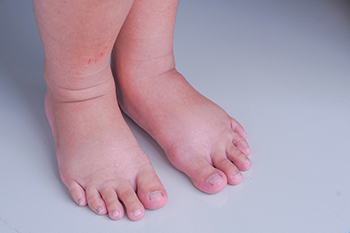
Swollen feet, or edema, a common and often uncomfortable condition, can stem from various factors, each shedding light on the intricate workings of our body. Prolonged periods of standing or sitting, especially in hot weather, can lead to fluid retention, causing feet to swell. Additionally, injuries such as sprains or fractures trigger an inflammatory response, resulting in localized swelling. Conditions like venous insufficiency, where veins struggle to return blood to the heart, contribute to fluid buildup in the lower extremities. Heart, kidney, or liver issues may also manifest in foot swelling as the body retains excess fluids. Pregnancy, hormonal changes, and certain medications can further exacerbate this phenomenon. If your feet have become swollen, it is suggested that you confer with a podiatrist who can determine what the cause is, and offer tips for relief.
Swollen feet can be a sign of an underlying condition. If you have any concerns, contact Patrice Antero, DPM of Tuscany Podiatry. Our doctor can provide the care you need to keep you pain-free and on your feet.
Swollen feet are a common ailment among pregnant women and people who stand or sit for extended periods. Aging may increase the possibility of swollen feet and patients who are obese often notice when their feet are swelling too. There may be medical reasons why swollen feet occur:
- Phlebitis - A condition that causes the veins to become inflamed and can also cause leg pain.
- Liver disease - This may lead to low blood levels of albumin which is a protein. This can cause fluid in the blood to pass into the tissues and several areas of the body can become swollen.
- Heart failure - When the heart doesn’t pump properly the blood that is normally pumped back to the heart can pool in the veins of the legs causing swollen feet.
- Kidney disease - One of the main functions of the kidneys is releasing excess fluid in the body. This type of condition can make it difficult for the kidneys to function properly, and as a result the feet may become swollen.
- Deep-vein thrombosis (DVT)- This is a serious condition where blood clots form in the veins of the legs. They can block the return of blood from the legs to the heart which may cause the feet to swell. It is important to be treated by a podiatrist if this condition is present.
Swollen feet can also be caused by bone and tendon conditions, including fractures, arthritis, and tendinitis. Additionally, there may be skin and toenail conditions and an infection may cause the feet to swell. Patients who take medicine to treat high blood pressure may be prone to getting swollen feet.
Many patients elevate their feet to help relieve the swelling and this is generally a temporary remedy. When a podiatrist is consulted the reason behind the swelling can be uncovered and subsequently treated.
If you have any questions please feel free to contact our office located in Tuscaloosa, AL . We offer the newest diagnostic tools and technology to treat your foot and ankle needs.
Causes and Symptoms of a Bunion
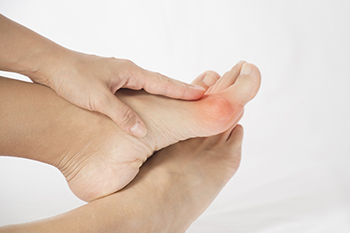
A bunion, a common foot deformity, is characterized by the gradual misalignment of the joint at the base of the big toe. This condition results in the enlargement of the joint, causing the big toe to angle toward the other toes. Bunions can lead to discomfort and pain due to the increased pressure on the joint and the rubbing of shoes against the protruding bone. Symptoms often include redness, swelling, and tenderness at the affected site, accompanied by restricted movement of the big toe. Wearing ill-fitting shoes, especially those with a narrow toe box, can exacerbate bunion development. Genetics also play a role, as certain foot structures and inherited tendencies can contribute to bunion formation. If you have a bunion, it is strongly suggested that you visit a podiatrist who can provide you with appropriate relief and treatment options.
If you are suffering from bunions, contact Patrice Antero, DPM of Tuscany Podiatry. Our doctor can provide the care you need to keep you pain-free and on your feet.
What Is a Bunion?
A bunion is formed of swollen tissue or an enlargement of boney growth, usually located at the base joint of the toe that connects to the foot. The swelling occurs due to the bones in the big toe shifting inward, which impacts the other toes of the foot. This causes the area around the base of the big toe to become inflamed and painful.
Why Do Bunions Form?
Genetics – Susceptibility to bunions are often hereditary
Stress on the feet – Poorly fitted and uncomfortable footwear that places stress on feet, such as heels, can worsen existing bunions
How Are Bunions Diagnosed?
Doctors often perform two tests – blood tests and x-rays – when trying to diagnose bunions, especially in the early stages of development. Blood tests help determine if the foot pain is being caused by something else, such as arthritis, while x-rays provide a clear picture of your bone structure to your doctor.
How Are Bunions Treated?
- Refrain from wearing heels or similar shoes that cause discomfort
- Select wider shoes that can provide more comfort and reduce pain
- Anti-inflammatory and pain management drugs
- Orthotics or foot inserts
- Surgery
If you have any questions, please feel free to contact our office located in Tuscaloosa, AL . We offer the newest diagnostic and treatment technologies for all your foot care needs.



